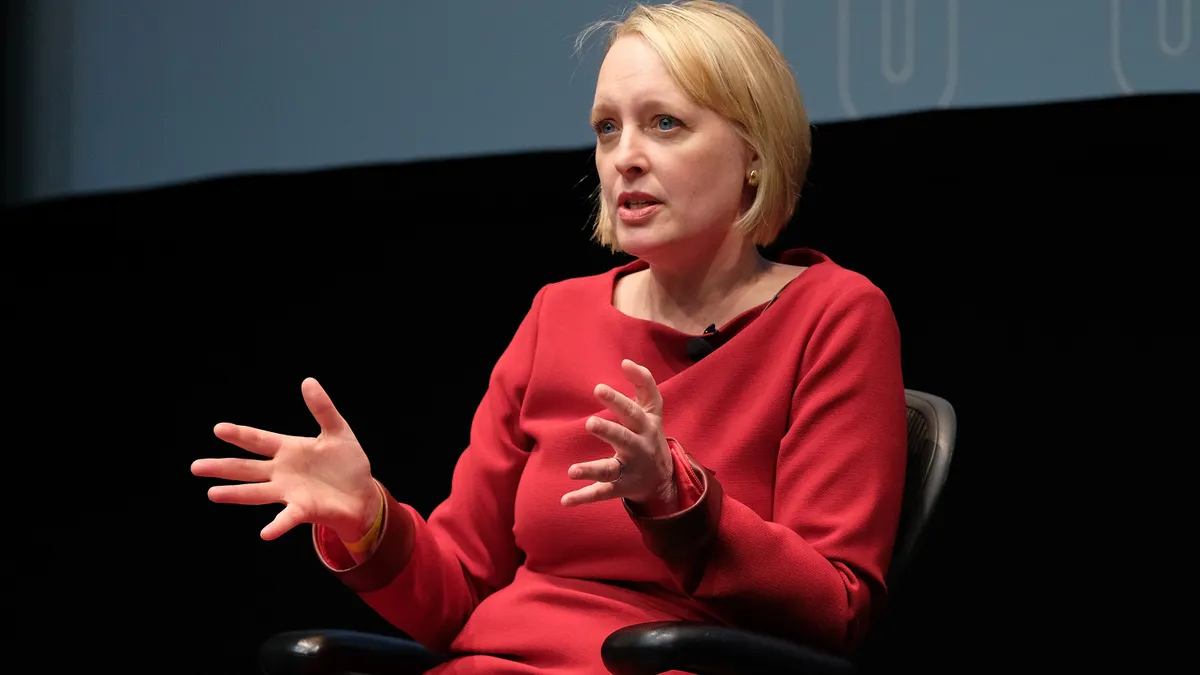What a difference a year makes.
Last January, the HR industry braced itself for a period of regulatory uncertainty with the inauguration of President Donald Trump, whose campaign hammered on the large volume of regulations placed on businesses by his predecessor. That, coupled with a last-minute injunction halting changes to the overtime rule, made it clear that keeping a workplace compliant in 2017 would be a challenge.
But the year wasn't just about Washington. HR departments across the country played a crucial role in one of the year's largest controversies, an avalanche of incidents wrapped into one succinct hashtag (#MeToo). And the push to make the workplace a safer, more diverse environment meant a steady stream of tasks for the HR department and renewed scrutiny for the critical role it plays.
In 2018, a new round of trends and some recurring themes are likely to shape the HR landscape.
#1: The changing role of the CHRO
The CHRO role has been shifting for years, and 2018 may be the year we see this shift go full-throttle.
HR generally has seen dramatic changes in how talent is identified, onboarded and supported in the past five to seven years, Jim Link, CHRO, Randstad North America, told HR Dive. While the people skills at the core of HR will remain key, execs will need to be “equally adept” at numerical reasoning, fiscal responsibility and understanding the impact of automation, he said.
There are a number of company leaders who have said they won’t hire “any more HR people who don’t understand statistics,” Josh Bersin, founder and principal of Bersin by Deloitte Consulting LLP, said. Those HR execs that don’t grasp visual thinking, strong digital communication skills, organizational design and data security will be behind their peers in top-performing companies.
“One of the things we are seeing in our research time and again is this whole shift from traditional HR models to a more evidence-driven HR,” Madhura Chakrabarti, research leader of people analytics and employee engagement at Bersin, said. CHROs will need to focus on being a proponent of employee experience design as a more scientific and data-based process overall.
CHROs that are more aware of the employee experience from the “ground floor” up, so to speak, will differentiate themselves from competition which may still be focused on simpler engagement tactics, she added.
“People are talking about experience more because it’s time to move beyond engagement,” Chakrabarti said. “It’s only part of the entire equation.”
#2: A focus on branding and the employee experience
What is the employer and employee brand? According to some experts, those brands have become synonymous with “brand” overall.
CHROs are facing a battle familiar to another C-suite partner — the chief marketing officer. If you are a CMO and not digitally savvy, you are “up the creek without a paddle,” said Leela Srinivasan, CMO of Lever, a recruiting software firm. CHROs face a similar issue now that much of their focus has pinpointed on employee brand.
“The whole employee value proposition is becoming important in that how do you portray that to a candidate?” Chakrabarti said. “Thinking about the employee lifecycle, brand is now part of it.”
Don’t expect employees to keep this simple, either. More employees, especially younger workers, are seeking individualized, tailored career experiences from their employers — and employers aren’t especially good at this yet, Link said.
“[Employers] want things to be the same because they feel that is fair, is just and that is what people want, but it is not 1955,” he added.
One employer that’s done this consistently well? The U.S. military, Link said. They sell an idea to future employees, and surround that idea with expectations and visuals that project honor and pride — an employee experience many can believe in.
#3: Upskilling and the new talent pipeline
The skills gap is a megatrend that could take up its own long-form feature. But how employers will continue to attack the problem will remain a key trend to watch in 2018.
Expect to see employers work both externally and internally to shore up their talent pipelines. Many big names announced partnerships with local schools and started programming in local cities this past year in an effort to connect with potential future employees, teach in-demand skills and prepare the next generation for the future of work. To see real success, however, more employers will need to get with the program, Link said.
“There has to be a lot more of that going on, and you can brand some of those approaches even,” he said. “It’s at a grassroots level. But most employers don’t take the time or energy to understand that is the approach they need to take.”
HR execs who don’t grasp visual thinking, strong digital communication skills, organizational design thinking and data security will be behind their peers in top-performing companies.

Internally, HR will need to focus on creating a culture of development, especially if employers want to be prepared for the continued transformations occurring in how people work. Entire systems may need overhauling.
The fact remains that there’s almost no long-term, 20-year career, and HR needs to lead that transformation, Chakrabarti said. “What does that mean for how we assess performance? What does learning mean when we have 10,000 people off our balance sheet but still part of the organization?”
One of the biggest innovations in overcoming the skills gap may include the contingent workforce, which brings a whole new set of challenges for HR leaders to contend with. Innovation may lie in an organization's ability to scale up its talent needs on a whim, but how do you manage a contingent team that has to perform its best and be engaged on day one without a built-in onboarding process? That will be one of the bigger challenges HR leaders face in the new year.
#4: Fighting harassment and improving inclusion
Harassment stories continue to make headlines, and HR knows that a culture that permits harassment to persist brings low morale and engagement, which affect the bottom line. Employers made some strides in 2017, but for harassment to truly be contained, a focus on inclusion more broadly will become "imperative," Chakrabarti said.
"Every organization has different success factors, but a leader that can see the benefit of inclusion is at the top of the list," she added. "Psychological safety is a really important factor of this."
Put simply, workers must feel safe and supported by company leadership while at work. This statement may seem obvious, but the events of 2017 made it especially clear that HR must publicize this intent and establish itself as a resource for employees going forward. Indeed, 2018 may be a year of reflection — a year in which employers examine their structures to discern why women and people of color may be consistently left out of leadership positions, especially in certain industries.
"In the last five years, there's been the realization that if you don't have an inclusive workplace you are doomed to failure," Srinivasan said. When employees can't feel like they can thrive, an employer has little basis for real growth.
Such cultures also present a compliance problem. Harassment based on sex that is allowed to persist is a form of discrimination prohibited by Title VII of the Civil Right Act of 1964. Mike Aitken, VP of government affairs at the Society for Human Resource Management, said the organization believes great progress has been made but that more needs to be done, and that everyone needs to be involved. “We’re all in this,” he said, “HR, leadership, employees.”
What’s not clear, however, is how to achieve a harassment-free workplace, he said. Is it more education? Is it a better understanding of what constitutes harassment? Or is it employers prohibiting all harassment, even actions that aren’t prohibited by law? That final option, of course, is the one plaguing even federal officials; at some point, does something like a “no negativity” rule begin to chill workers’ National Labor Relations Act rights?
Additionally, lawmakers at both the state and federal level are considering bills that would bar nondisclosure agreements in sexual harassment claims. But, again, says Aitken, these proposals may need a closer look. The federal one, for example, would (perhaps unintentionally, Aitken noted) encompass more than just harassment. “This really needs to be thought through for the implications for other employment practices,” he said.
#5: Sexual orientation protections
Courts remain split on whether Title VII prohibits discrimination based on sexual orientation and gender identity, and the Supreme Court recently declined to weigh in. It may do so in its next term but, for now, employers are left with a patchwork of rulings on the issue and enforcement agencies that disagree with each other. Some experts have recommended that employers add LGBTQ employees to their EEO policies to avoid becoming a test case.
Aitken said SHRM fully supports the idea the Congress should add such protections to Title VII. As for adding LGBTQ employees to your EEO policy ahead of time, Aitken says employers should carefully think through the implications of doing so. Things written in your handbook could be construed as a contract, he noted. This means that if there’s a violation, you could potentially be held liable for failing to take the same steps you would for other protected characteristics. You always want to think through whether those are the values that you live by, Aitken said; it can’t just be window dressing.
#6: Worker compensation and classification
Employers saw the beginnings of a shift around both worker compensation and classification last year.
The pay transparency movement got a boost when Google announced that it would begin displaying salary info next to job postings. New salary history bans put in place by various state and local governments may very well push that initiative forward, too.
Aitken said these shifts may at least lead employers to do a better job of explaining how salaries are set. And that, in turn, may result in fewer problems; after all, research shows that how employees feel about their organization's approach to pay fairness and transparency has a higher impact on job satisfaction than the salary itself.
Worker classification remains an area to watch, too. The U.S. Department of Labor has withdrawn Obama-era guidance on the topic but has not replaced it. Litigation involving the gig economy's biggest names (like Uber and GrubHub) has made headlines, but experts disagree on how much weight to place on the outcomes of these suits because they involve highly fact-specific situations. The U.S. Supreme Court could soon weigh in, but even if it decides to hear the case, a resolution would be months away.
#7: State and local laws
As the Trump administration began rolling back everything it could, employers started voicing concerns about an uptick in state and local legislation. Aitken says you’re not imagining it. Because of a lack of federal activity, state and local governments started to step into the breach, he told HR Dive.
But employers feel like legislators aren’t paying attention to the administrative burdens that come with this patchwork of laws, Aitken said. First, they assume that large employers can easily comply. But that’s not always true, he said; tracking all of these laws across multiple jurisdictions is expensive and time-consuming. Second, it’s not always as simple as merely complying with the most generous law; the various notice provisions in these laws alone can cause even a well-intentioned employer to run afoul of a law, he said. “It’s just simply not that easy.”
"Every organization has different success factors, but a leader that can see the benefit of inclusion is at the top of the list."

Madhura Chakrabarti
Research Leader of People Analytics and Employee Engagement, Bersin
Some say this trend shows no signs of slowing down, but employers and industry groups are pushing back with both litigation and lobbying efforts. SHRM itself is behind a bill that aims to address the patchwork of paid leave laws. And Aitken says stakeholders also may start to see some of the political divisiveness that exists in Congress trickle down to states, potentially causing stalemates similar to those we’ve seen at the federal level. “I think it’s going to be an interesting year,” Aitken said.
#8: Personalization of benefits delivery and communication
Benefits used to be a passive thing for most workers: fill out this form, select from a limited list of company offerings, hand the form back into HR and wait. It took a massive revamp of the enrollment process to change this, and key players are leaning heavily on tech vendors to push the boundaries further.
2017 saw an industry-wide explosion of interaction-focused, on-demand apps for personal health, wellness programs, personal finance and other aspects. Now the goal is to take that user experience and make it even more personal.
"Those on the cutting edge of benefits planning and making benefits decisions are really taking a step back from a product-centric view of 'how to get your employees well,'" said Tom Conlon, business success executive at Betterment for Business, "and really looking at, 'how do we optimize our employee experience and our employee journey?'"
#9: Ballooning employee debt and a focus on financial wellness education
It's all well and good to seek out young talent, but you won't have the full attention (in recruiting or in the workplace) of millennial and Generation Z workers if you ignore their financial wellness. One of the most cited statistics puts the total combined student debt among U.S. workers at $1.4 trillion.
Even parents of college grads feel the pain, as they're often footing some of the bill. Enter Congress: bipartisan solutions to the problem have been on the table for months. "Everything I've read is that if [one of those bills] is passed, student loan repayment benefits will skyrocket," said Jeff Oldham, senior VP of employer sales for Benefitfocus.
Your 401k plan likely needs some additional attention, too. Look for guided investment apps and flexible options around payroll to pick up further adoption in 2018.
#10: Consolidation of vendors, retailers and healthcare insurers (i.e. CVS, Aetna)
The HR tech space has seen monumental growth in the past five to seven years, driven by the same mobile-first tech that enabled similar growth in consumer-facing technologies. In 2018, we may see that growth focused more on consolidation, rather than expansion. But that doesn't mean innovation won't push forward in the new year, Chakrabarti said.
Investment remains high in HR tech, but much of that funding has gone into research and development, Srinivasan said. Smaller players that are focused on solving a single problem have snuck up on the large HRIS and ATS providers, who have turned to acquisition to keep up.
"Point solutions are elevating and evolving so rapidly that big suite players cant possibly keep up," Srinvasan said. "I can foresee there being pressure on the suite players to innovate super quickly which is not always possible. And plus, there are just so many providers right now."




















